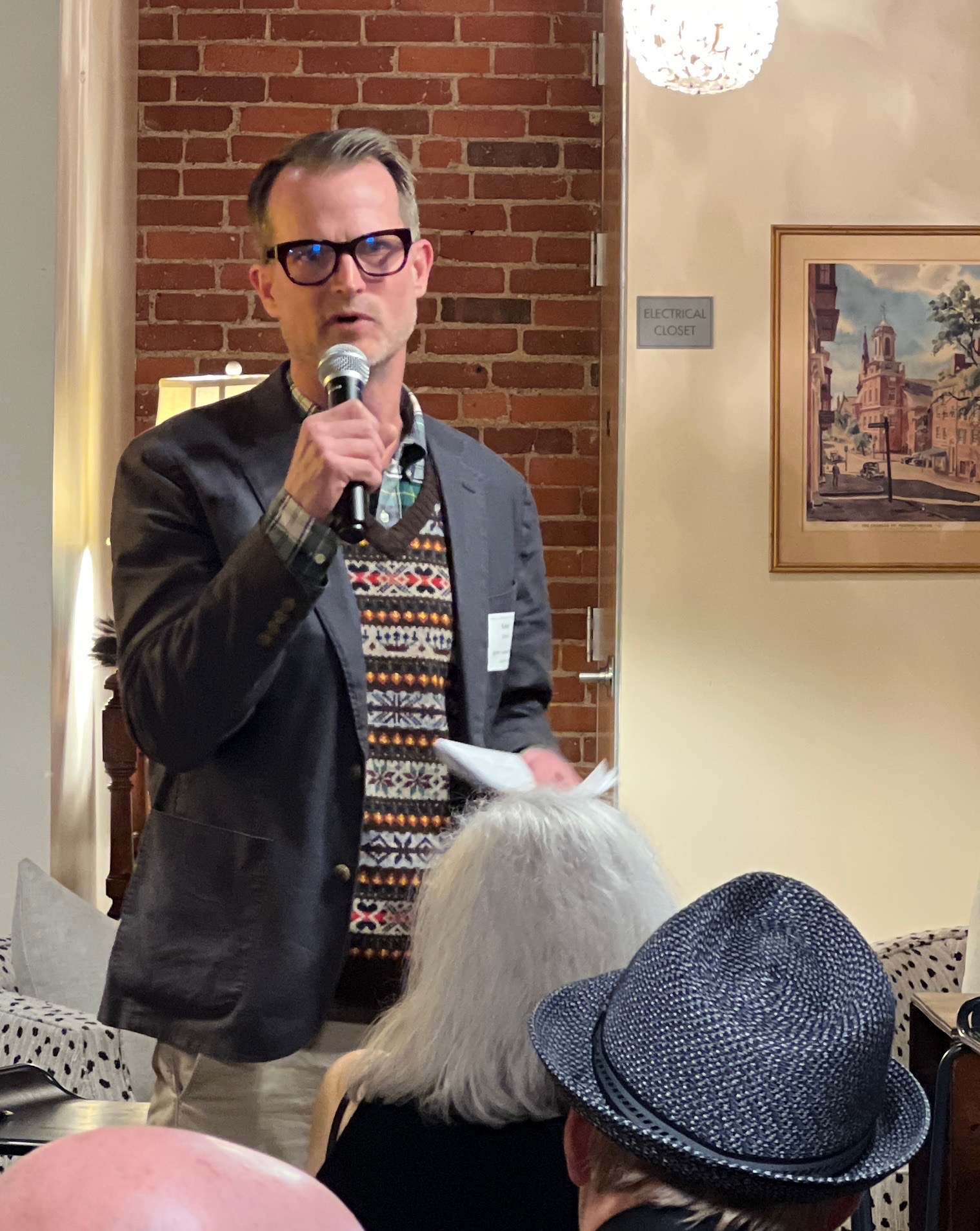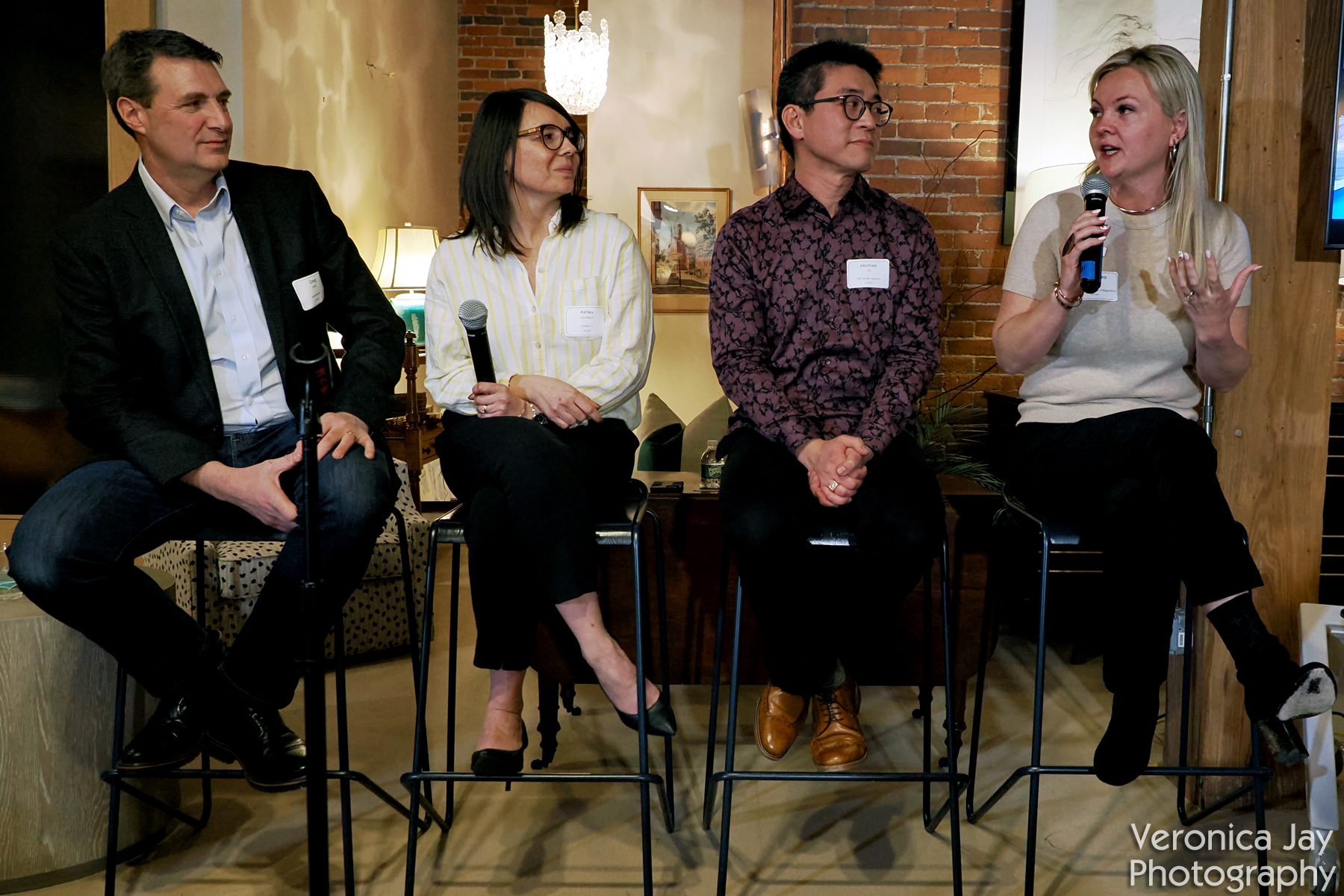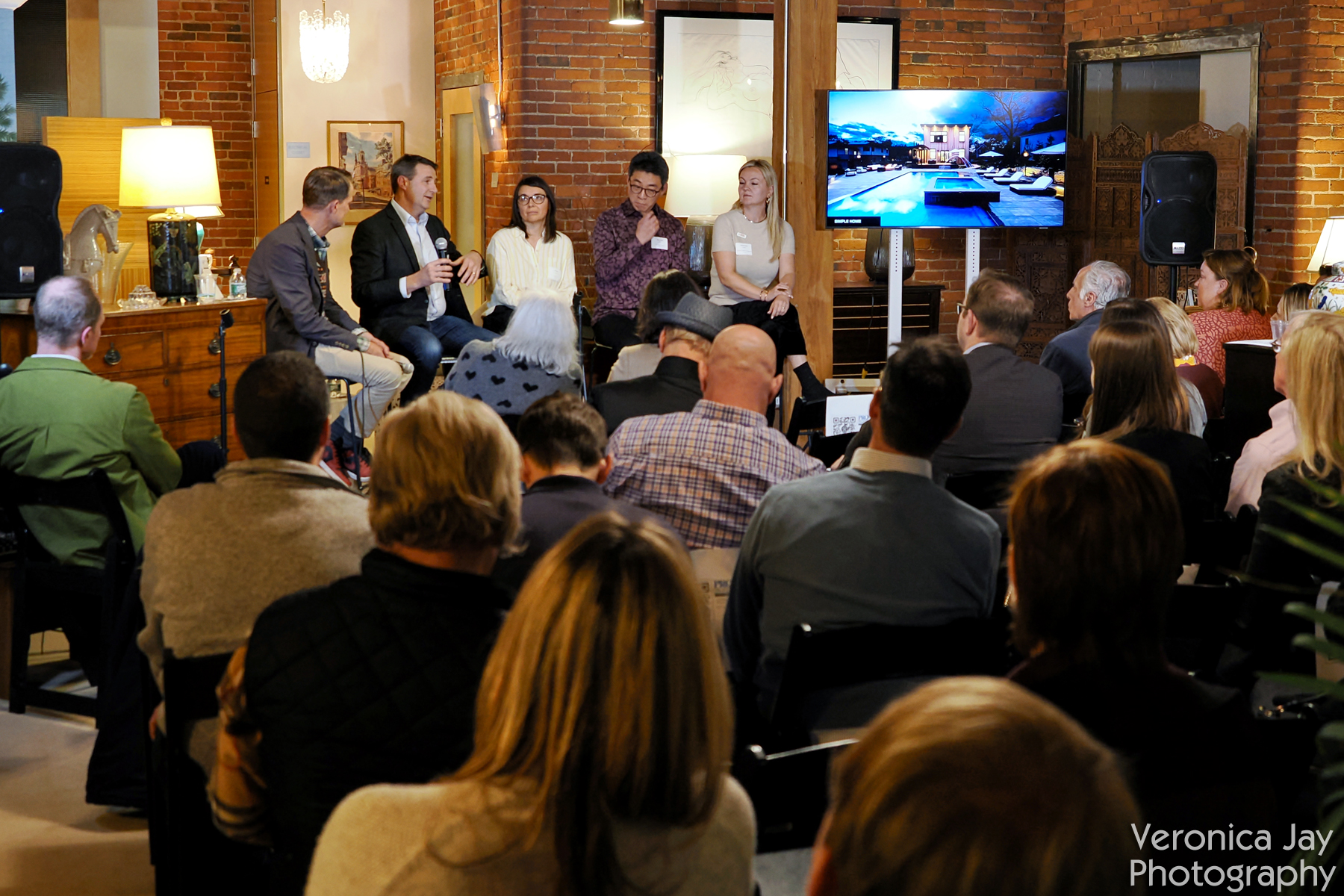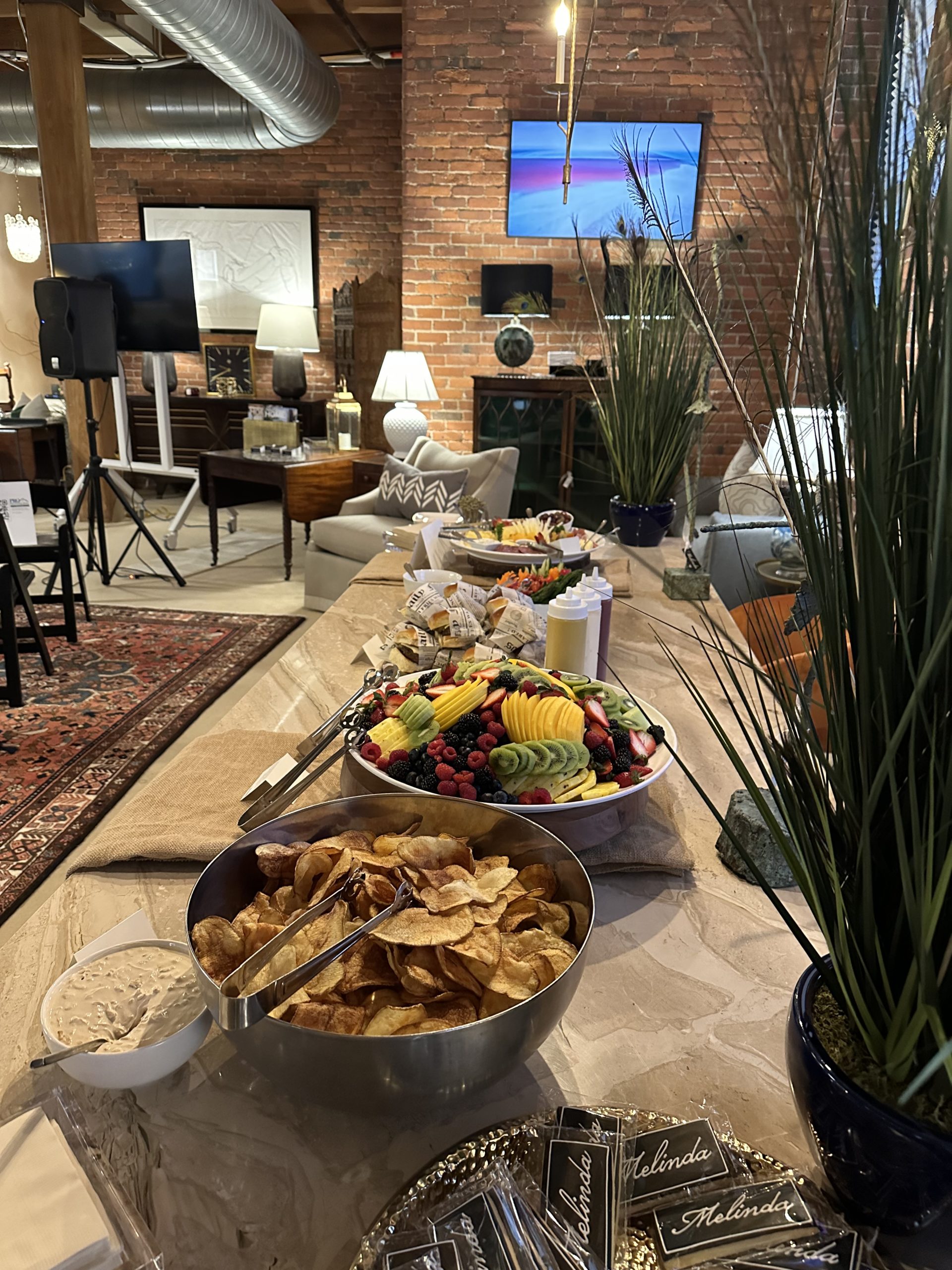By Cheryl Savit, Kevin Cradock Builders
The March PRO NE meeting took place at Chatham Interiors, Inc. in SoWa, with more than 85 members and guests in attendance. PRO NE Eric Adams kicked off the meeting with a welcome message and announcements, then introduced Melinda Headrick of Chatham Interiors and Melinda. She set the tone with her opening remarks about the passion everyone in the room has for creating something special for clients. She then related a story about working for Blackberry Farm and at a meeting she attended early in her career. A tradesperson began speaking in technical terms, and her boss stopped him and asked him to explain in “layman’s terms.”
What Headrick learned from that interaction was, “You don’t have to know everything, but ask and learn and grow from that.” Another lesson Headrick took away from her time at Blackberry Farm was “impeccable customer service.” As an interior designer and business owner for the past 20 years, she has collaborated with architects, builders, specialty designers, subcontractors, and vendors. Headrick opened her Boston showroom in autumn 2022 and warmly welcomed everyone into her beautiful space.

Kevin Cradock moderated the panel of smart home integrators and designers. “Why am I here? I’m on the board of PRO, and I’m also part of this luxury design community,” he said. “My objective is to expose everyone to be in Boston and this type of space and the projects that I work on and to merge these two groups. I think we have a first here because I don’t think we’ve ever had these big four integrators in the same place at the same time. One thought I have is when thinking about smart home technology, it is a luxury item, but it is also a practical thing. There are a lot of reasons beyond having a fancy high-tech house: there’s health, energy conservation, remote monitoring for anyone who travels, and security. It’s a really deep subject. I think we’re going to get to the tippy-tip of the iceberg. We’re going to try to tackle it in an hour. I want to get the amazing panelists’ perspective on what they do.”
The panelists introduced themselves, beginning with Greg Brett, one of three owners of simpleHome, (the result of merging Audio Video Design, Sounds Good, and Creative Systems) “to create a platform that can better serve everything we want to do. Our big specialty niche is our service platform. We bring a dedicated 24/7 service model to the industry. We focus on the end user because our relationship continues where everyone else’s ends. After the home is built, we’re still servicing the client’s system.”
Ashley Jacobson, a partner at System 7, introduced herself. “System 7 was founded on the design, and one of our main approaches to technology is trying to incorporate our systems with the architecture itself. I joined the team with my degree in architecture about 13 years ago, and from that point on, we’ve tried to evolve our approach about what technology is and can do.” Over the years, they’ve brought specialty into the company by acquiring The Boston Shade Company and, more recently, Wolfers’ Lighting. “We’ve focused on the lighting, shading, and technology pieces of the business and to evolve what people think about technology. How a room feels and how it impacts the person living there.”
Michael Oh, President and Founder of TSP Smart Spaces, explained how he started off in the IT and cybersecurity industry after starting a company – Tech Super Powers, as a freshman at MIT. “That company was always about helping people connect to the Internet. About 15 years ago, we had clients who were executives who had smart homes that weren’t working well for them, so they brought us in to fix those things and scroll 15 years ahead. we’ve made it half of our business now.” TSP Smart Spaces, also located in the same building at Chatham Interiors Inc. at 500 Harrison Avenue, implements smart home technology as well as commercial AV and smart building technology.
Alexa Centeno, co-owner of Systems Design Integration, began by thanking everyone for coming and said she was “honored to be on the panel with you today. We’re a husband and wife team with a showroom in Needham. We’ve been in the technology space for 15 years, beginning with simple TV installations, and have grown tremendously with our services and what we provide – from WiFi networks to full lighting control throughout the house and motorized shades and draperies. We have evolved so much in the last 15 years, and it’s all about designing around art and technology. You all build beautiful homes, and we’re so happy to be able to collaborate and integrate with them.”

Which brought Kevin to one of his key questions of the evening: “What do you call yourselves? Do you call yourselves the same thing?”
Brett said when you bring different companies together, you get “nine different answers. So we always called ourselves electronic systems contractors, and then as everything evolved, we started getting more into system design contractors, now home systems integrators. It’s ever-evolving.”
Ashley said, “I just don’t want to be called AV dude. I don’t think any of us do. We call ourselves technology designers because it really encompasses everything from a TV on your wall to a light fixture in your ceiling and everything in between.”
Michael said they call themselves technology integrators and design integrators at TSP Smart Home because “integrator seems to be part of the lingo in the industry. What I tell people I meet is that we’re technology architects. In the same way that the architect is going to be designing the physical built environment, we’re looking at things more behind-the-scenes like the wiring and all of the technology in the home.”
Alexa acknowledged that there are so many different terms for what they do, but as the field evolves, she’s good with changing vernacular. “We’re automating, we’re integrating, we’re designing,” she explained. “We’re part of an industry organization called CEDIA which stands for the Consumer Electronics Design and Installation Association.” According to their website, they refer to themselves as the global smart home technology association.
Kevin summed up by saying design keeps coming up. “They do help us design, and they’re an integral part of the team. I advocate for bringing a smart home designer on board at the beginning of a project.”
Design is one of Ashley’s favorite topics. She pointed out that you bring in credentialed team members for HVAC, architecture, and other elements of a home, but technology doesn’t require a certified person, but it is evolving quickly. “How do we make technology complement the architecture, the plumbing, the windows? Bringing in technology design ahead of time, incorporating it into the window detail, the ceiling framing and figuring out all of those items. before the walls are up are the most important feature in a home with technology. I think we would all agree that we want to be brought in when schematic designs are being done,” Ashley said. An example Ashley gave was going from a light switch with 6 buttons to a single keypad on a wall.
Kevin agreed that when technology is an afterthought, it can be frustrating because once the construction is mostly complete, it’s difficult – if not impossible – to add those items to a project. That’s when it can be very costly in time and resources.

Having a knowledgeable smart home design expert on the team makes sense at any entry price point. Budget and pricing came up as a topic in the discussion. And while there are expensive whole-house technology systems and top-of-the-line bells-and-whistles in the luxury market, there are also basic items that can be incorporated into remodeling projects as well as new construction. People come to technology designers and integrators because they care a lot about how the technology looks and functions in their homes.
Michael Oh pointed out that the “Big Box” stores are becoming more involved in the industry. Traditionally people buy AV through these retailers. And while those solutions are not for everyone, they bring awareness to all of the choices available to professionals and homeowners alike. The same goes for electricians, who can definitely handle some of the smart home setup tasks but certainly not all. “We prefer to collaborate and work hand-in-hand with electricians,” said Alexa, and that was the consensus across the panel. Again, the advantage of working with technology design and integration companies is that they bring another level of solution creativity and experience to a project. They can help sort through the myriad choices available in hardware and software.
There were many great questions from the audience, and the panelists all took turns providing thoughtful answers. The hour (plus) went by quickly, and not all of Kevin’s “six pages of questions” were addressed in this first-time home technology panel. A video and separate audio recording of the entire panel will be made available soon.

